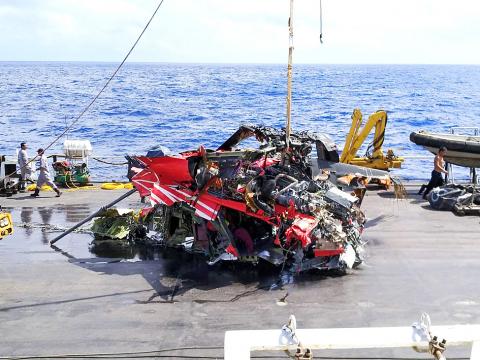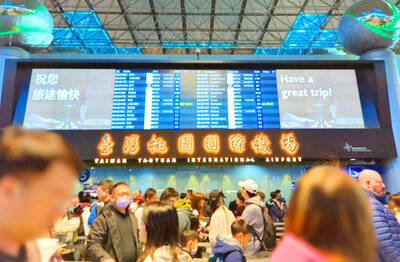The pilots’ lack of training and turbulence contributed to the crash of a National Airborne Service Corps (NASC) NA-907 helicopter in February last year, a Taiwan Transportation Safety Board (TTSB) investigation has determined.
According to the report released yesterday, the Sikorsky UH-60 Black Hawk helicopter, which had been deployed to bring a patient from Orchid Island (Lanyu, 蘭嶼) to Taitung on Feb. 5, crashed into the sea about 81 seconds after taking off from Lanyu.
All six people aboard were killed, but four bodies were never recovered.

Photo courtesy of the Aviation Safety Council
Debris from the helicopter was later retrieved from a depth of about 1,000m below the surface, but the cockpit and tail have never been found, the report said.
The pilots lacked the ability to manage the threat to the aviation environment, to detect and communicate problems and to take decisive actions in emergency situations, Aviation Occurrence Investigation Division Director Chang Wen-huan (張文環) said.
Their recorded conversations in the cockpit also showed that they were deficient in their understanding of the aircraft’s operating system, he said.
“They did not use the correct takeoff mode when they departed at nighttime and when there was a variable wind. They also failed to maintain a safe ascending altitude and speed during the takeoff stage. When they encountered turbulence, they did not detect in time the changes in altitude and speed and respond accurately to the situation,” he said.
“It was also possible that they were experiencing spatial disorientation. Failing to heed that their aircraft was at a low altitude, the pilots then applied excessive horsepower and operated at a large angle of depression, which caused the aircraft to crash into the sea,” Chang said.
The pilots encountered a downwind about 23 seconds after takeoff, with the wind speed at one point reaching 40 nautical miles per hour (74kph), the board found.
However, the aircraft could have still safely operated despite the wind shear and the turbulence, and dashboard data did not indicate that the helicopter had any abnormalities, it said.
In addition, the investigation found that the NASC had failed to comply with standard operating procedures for Black Hawk helicopters and to have a comprehensive training plan and resources for pilots flying them, it said.
Under normal circumstances, a helicopter pilot should spend about 190 hours training in a flight simulator before being given an assignment, but the two pilots involved had only 90 hours, Chang said.
However, because the NASC had not stipulated minimum simulation training hours, it did not infringe any regulations, he added.
The board report offered several suggestions to improve the NASC’s operational safety: reinforce pilots’ aviation threat management, emergency detection and decisionmaking abilities and enhance pilots’ knowledge of aircraft functions.
The NASC should stipulate standards that pilots have to meet before they are given a flight assignment, such as minimum hours spent on simulators, and establish rules governing the nighttime delivery of patients, the board said.
The NASC’s training standards for pilots is to be reviewed and the board will decide whether to accept them after comparing them with those in other nations.
The board also asked Civil Aeronautics Administration (CAA) to enhance the lighting and guiding functions on Lanyu Airport’s runway to deal with night flights.
If that is not possible, the CAA should quickly stipulate operating procedures for helicopters departing from the airport at night, the board said.

Three Taiwanese airlines have prohibited passengers from packing Bluetooth earbuds and their charger cases in checked luggage. EVA Air and Uni Air said that Bluetooth earbuds and charger cases are categorized as portable electronic devices, which should be switched off if they are placed in checked luggage based on international aviation safety regulations. They must not be in standby or sleep mode. However, as charging would continue when earbuds are placed in the charger cases, which would contravene international aviation regulations, their cases must be carried as hand luggage, they said. Tigerair Taiwan said that earbud charger cases are equipped

Foreign travelers entering Taiwan on a short layover via Taiwan Taoyuan International Airport are receiving NT$600 gift vouchers from yesterday, the Tourism Administration said, adding that it hopes the incentive would boost tourism consumption at the airport. The program, which allows travelers holding non-Taiwan passports who enter the country during a layover of up to 24 hours to claim a voucher, aims to promote attractions at the airport, the agency said in a statement on Friday. To participate, travelers must sign up on the campaign Web site, the agency said. They can then present their passport and boarding pass for their connecting international

Temperatures in northern Taiwan are forecast to reach as high as 30°C today, as an ongoing northeasterly seasonal wind system weakens, the Central Weather Administration (CWA) said. CWA forecaster Tseng Chao-cheng (曾昭誠) said yesterday that with the seasonal wind system weakening, warmer easterly winds would boost the temperature today. Daytime temperatures in northern Taiwan and Yilan County are expected to range from 28°C to 30°C today, up about 3°C from yesterday, Tseng said. According to the CWA, temperature highs in central and southern Taiwan could stay stable. However, the weather is expected to turn cooler starting tonight as the northeasterly wind system strengthens again

Taiwan sweltered through its hottest October on record, the Central Weather Administration (CWA) said yesterday, the latest in a string of global temperature records. The main island endured its highest average temperature since 1950, CWA forecaster Liu Pei-teng said. Temperatures the world over have soared in recent years as human-induced climate change contributes to ever more erratic weather patterns. Taiwan’s average temperature was 27.381°C as of Thursday, Liu said. Liu said the average could slip 0.1°C by the end of yesterday, but it would still be higher than the previous record of 27.009°C in 2016. "The temperature only started lowering around Oct. 18 or 19